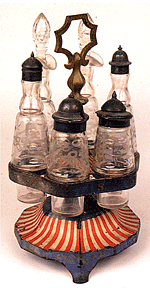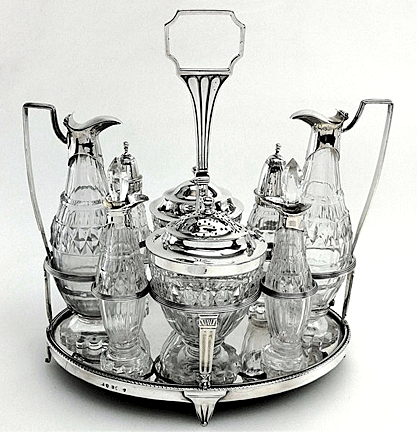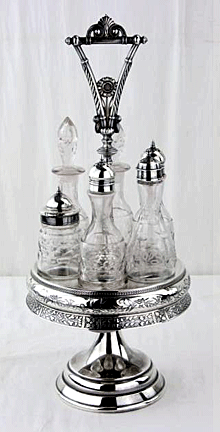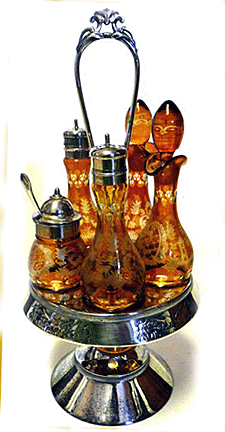Castor Sets Highlighted Victorian Tables
by Bob Brooke
 Just
about every Victorian dinner table had a device called a castor, filled
with jars and bottles of condiments, sitting in its center. According to
directions for setting the table given in cookbooks of the period,
that’s exactly where it should have been. The revolving castor set was
one of the most widely used pieces of Victorian tableware. The castor
set was such an important part of the table setting, that no matter how
humble, a family would have one sitting in the middle of their table.
But castor sets go back even further. Just
about every Victorian dinner table had a device called a castor, filled
with jars and bottles of condiments, sitting in its center. According to
directions for setting the table given in cookbooks of the period,
that’s exactly where it should have been. The revolving castor set was
one of the most widely used pieces of Victorian tableware. The castor
set was such an important part of the table setting, that no matter how
humble, a family would have one sitting in the middle of their table.
But castor sets go back even further.
People used castor sets holding just salt and pepper as far back as the
17th century. Sterling silver castor sets, containing a sugar castor,
mustard pot, spice dredger or shaker, bottles for vinegar and oil, and
other spice holders became popular by the 18th century. But it was the
Victorians that made the castor set de rigeur at meals.
The American Victorian castor set, made of silver plated Britannia
metal, is the type most collected today. It held several glass bottles.
One pair was for salt and pepper. Usually there was a pair with glass
stoppers for oil and vinegar. One bottle had a hinged lid with a slot
for a spoon. This was for mustard. Other bottles could hold soy sauce,
spices or “castor” sugar which was a pounded sugar—not powdered sugar
and
not granulated sugar—which cooks made by pounding loaf sugar with a
mortar and pestle.
 Though
castor manufacturers produced bottles made of plain or etched glass,
people could also purchase ones made of more expensive cut glass
designs, available in blue, amber and cranberry after the American Civil
War. Manufacturers also offered buyers a choice of handles and cruet
styles. Some fancy castors, made with cut-glass cruets and spice holders
plus figurines, even included a bell to ring for a servant. Others had a
flower vase and some had a revolving frame. Some castors had a removable
bottle rack so that the base could be used as a container for fruit. Though
castor manufacturers produced bottles made of plain or etched glass,
people could also purchase ones made of more expensive cut glass
designs, available in blue, amber and cranberry after the American Civil
War. Manufacturers also offered buyers a choice of handles and cruet
styles. Some fancy castors, made with cut-glass cruets and spice holders
plus figurines, even included a bell to ring for a servant. Others had a
flower vase and some had a revolving frame. Some castors had a removable
bottle rack so that the base could be used as a container for fruit.
There were several different types of castor sets. The simplest included
perhaps only salt and pepper shakers and a container for sugar.
Breakfast castors generally included three or four bottles while dinner
castors, the most elaborate, consisted of a silver or silverplate frame
which held five or six cruets.
 Though
castors had been used on tables early in the 19th century, the earliest
ones consisted of a footed tray with a center handle and weren’t
electroplated. They had a wide pierced band which served as a holder for
the bottles, of which there were usually six, plus small salt cellars.
Manufacturers used a wooden base on four feet, then topped it with an
ornate handle in the center. Though
castors had been used on tables early in the 19th century, the earliest
ones consisted of a footed tray with a center handle and weren’t
electroplated. They had a wide pierced band which served as a holder for
the bottles, of which there were usually six, plus small salt cellars.
Manufacturers used a wooden base on four feet, then topped it with an
ornate handle in the center.
In 1860, castors became more elaborate and had bottles of pressed glass.
Pressed glass bottle patterns ranged from Bellflower to Daisy & Button,
Beaded Dewdrop, Beaded Grape, Medallion Bull's Eye, Fine Cut, Fine Rib,
Gothic, Hamilton, Ivy, Honeycomb, Palmette, Powder & Shot, Thumbprint,
Roman Rosette and Eugenia.
The rotary castor, in which the bottles fitted into holes on a circular
platform which stood on a tall cone-type base, was patented in 1862.
Makers often decorated its center handle with elaborate openwork design
in one of several styles to go along with furniture of the time.
Eastlake castors were some of the most popular. In the 1870's, they
added heavy grape and beaded borders. Later, the low castor came back
into vogue and colored pressed glass containers with Daisy and Button
pattern or milk opalescent or cased glass became the rage, thus reducing
the silver frame to a few wires.
 Since
the Victorians had a myriad of tableware, each with its own use, there
were also pickle and salad castors, their containers being the most
interesting feature of these later castors. In addition to pressed glass
of blue, canary or crystal, makers used Pomona art glass, opalene twist,
imported, decorated ruby glass and cut crystal glass. The glass
containers had a fancy plated cover and decorated tongs were fastened to
the stand. Since
the Victorians had a myriad of tableware, each with its own use, there
were also pickle and salad castors, their containers being the most
interesting feature of these later castors. In addition to pressed glass
of blue, canary or crystal, makers used Pomona art glass, opalene twist,
imported, decorated ruby glass and cut crystal glass. The glass
containers had a fancy plated cover and decorated tongs were fastened to
the stand.
Since manufacturers produced silver castors in large quantities, many of
them have survived. However, they’re not always in good condition, and
many are missing some or all of their cruet bottles. The cost to replate
an antique six-bottle castor frame is about $110 to $130. It could be
more cost-effective to find a frame in good condition without the
bottles. If a collector needs one or two bottles, he or she may have
difficulty finding them to match their set. It’s sometimes easier to
find a complete set of six cruet bottles without the frame, especially
on the Internet, so the entire set could be replaced.
The castor set became old fashioned in the early 1900s. By World War I,
castor sets had fallen into disuse. People stashed them in cupboards and
eventually then ended up in flea markets and in antiques shops. Usually,
the silver plating has worn off completely or in places and some of the
bottles are missing. But when a collector finds one in great condition
with all of its parts, it’s like finding buried treasure.
<
Back
to More Antique Spotlights
Next Article >
|
